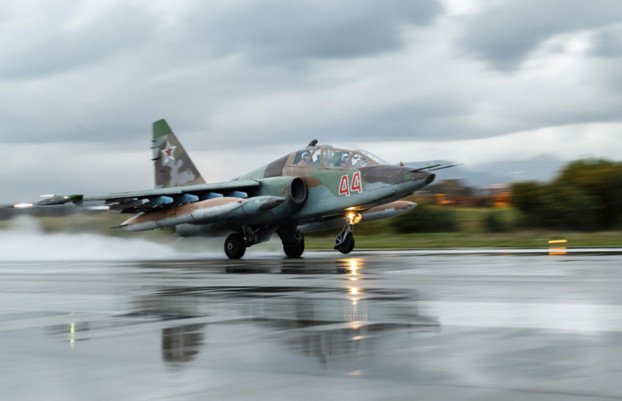
Beirut: On this exact day one year ago, Russian military jets started roaming the skies of Syria in what was supposed to be a short-term and limited operation against Daesh.
Authorised by the upper house of the Russian parliament and coming at the request of Syrian officialdom, the battles were supposed to end in January 2016.
The first targets of the Russian Air Force were the villages of Rastan and Talbiseh in the countryside of Homs in central Syria.
Over the past twelve months, they have widened their military operations, both horizontally and vertically, and are now present on all four corners of the Syrian battlefield.
Moscow’s decision to send troops to Syria came at the official request of the Syrian Government, reportedly as early as March 2015.
At the time, one city after another was falling to Syrian rebels.
Lebanese and Iraqi pro-Syrian Shiite militias were finding it increasingly difficult to confront the Syrian rebels, backed by Saudi Arabia and Turkey.
In 2012, half of Aleppo, the main metropolis of the Syrian north, fell to Turkish-backed rebels and so did its entire countryside.
Slowly, so did Deir Al Zor and Raqqa on the Euphrates River, along with the Damascus countryside and Idlib in northwestern Syria, which was seized by rebels in May 2015.
Kurdish troops took up arms in their villages and towns east of the Euphrates, fighting off both government troops and Daesh.
Soon President Bashar Al Assad’s stronghold coastal cities of Latakia and Tartous, both were surrounded by Syrian rebels stationed in the hills.
Damascus was panicking.
Moscow responded promptly to the Syrian request, sending aircraft and troops to the Hmaymeem airbase, southeast of Latakia, which has since become Russia’s main headquarters in Syria.
Moscow told international media its aim was to fight Daesh in Syria, but as events unfolded it became clear that they had broader aims.
Without seeking a UN resolution, Putin’s army began pounding Syria on September 30.
The Syrian Opposition cried foul play, claiming that the Russian Air Force was striking indiscriminately at all rebel groups and not exclusively against Daesh and the Al Qaida-affiliated Jabhat Al Nusra.
Within weeks, their campaign started to pay off, as they helped Syrian government troops regain the hills surrounding Latakia and Tartous, and entire stretches of land in the countryside of Aleppo and Hama.
In November, they overran the Kuwaires Airbase in the southeast countryside of Aleppo, where thousands of Syrian troops had been encircled for two years by rebel groups.
In December 2015, they killed Zahran Alloush in an air strike, the powerful commander of the Saudi-backed Jaish Al Islam, in the Damascus countryside, dealing a heavy blow to the armed opposition surrounding the Syrian capital.
In March, they retook the ancient city of Palmyra from Daesh and in mid-July helped the Syrian Army fully besiege Aleppo, preparing for an offensive that started this month, aimed at forcing rebel-held eastern parts of the city to surrender. Russia has 600 boots on the ground in and around Aleppo manning checkpoints in and out of the city on Castello road.
The ground troops — being Russia’s first in twelve months — are now part of a large military base that includes 12 Su-25 ground attack aircraft, 12 SU-24, four SU-30s, eight SU-34s, six Sukhoi SU-34 bombers, along with 15 helicopters, 35 military carriers, six T-90 tanks, and surveillance drones.
All of them are protected by three SA-22 surface-to-air anti-aircraft systems.
Twice over the past nine months, Russia and the US failed to sustain agreed-upon ceasefires. The first was in February while the most recent was in early September. Both failed and, at present, the Russian Air Force is heavily engaged in a vicious battle to re-take Aleppo by force.
In early August, Putin discussed Aleppo with his Turkish counterpart Recep Tayyip Erdogan, promising Russian support for eradicating the Kurdish threat on the Syrian-Turkish border in exchange for Ankara’s cooperation on the Russian military operations in Aleppo.
The Russians turned a blind eye at the Turkish military’s incursion into Syria to fight the growing threat from the Kurds, and in exchange, Ankara has been remarkably silent at Russia’s offensive in Aleppo.
On Sunday, the US accused Moscow of “barbarism” over the worsening carnage in Aleppo, as Syrian and Russian warplanes pounded the city in one of the heaviest bombing raids of the five-year war.
At an emergency meeting of the UN Security Council, Moscow and Damascus were repeatedly accused of war crimes.
“What Russia is sponsoring and doing is not counter-terrorism. It is barbarism,” US Ambassador Samantha Power said at the Sunday session.
Some 124 people, mostly civilians, have died since bunker-busting bombs and sophisticated weaponry were unleashed on residential areas in rebel-held eastern Aleppo after the army on Thursday launched an operation to take it.
“It is difficult to deny that Russia is partnering with the Syrian regime to carry out war crimes,” said British Ambassador Matthew Rycroft, adding that the high-tech weaponry had inflicted “a new hell” on war-weary Syrians.
UN Secretary-General Ban Ki-moon has also warned the use of advanced weaponry against civilians could amount to war crimes, and French Ambassador Francois Delattre said the atrocities must not go unpunished.
Britain, France and the United States had called for the urgent talks after days of intense diplomatic efforts to salvage a US-Russian ceasefire deal ended in failure at the weekend.
Ban called on world powers to “work harder for an end to the nightmare” in Syria that has left more than 300,000 people dead and driven millions from their homes.
To protest the attacks in Aleppo, the US, French and British ambassadors walked out of the Security Council chamber as the Syrian ambassador delivered his remarks.











